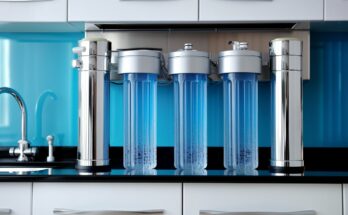The demand for clean, safe drinking water has never been higher. As consumers become increasingly aware of the potential health risks associated with contaminated water, many are turning to water purification systems to ensure their families’ well-being. Among the various options available, tankless water purifiers have gained significant popularity due to their efficiency, space-saving design, and continuous water supply.
Understanding Water Purifiers
Unlike traditional water purifiers that require a storage tank to hold purified water, tankless systems filter water on-demand. This means that the water is purified only when it’s needed, eliminating the need for bulky storage tanks. Tankless water purifiers are typically installed under the sink and connected to the cold water supply.
Key Factors to Consider When Choosing a Tankless Water Purifier
- Water Quality:
- Contaminants: Determine the specific contaminants present in your local water supply. This information can be obtained from your local water authority.
- Filtration Technology: Choose a purifier that is equipped with the appropriate filtration technology to address the contaminants in your water. Common filtration methods include sediment filtration, carbon filtration, and reverse osmosis.
- Household Size:
- Water Usage: Consider your household’s daily water consumption. Larger households may require a purifier with a higher flow rate to meet their needs.
- Number of Faucets: Determine how many faucets will be connected to the purifier. This will help you choose a system with the appropriate number of outlets.
- Budget:
- Initial Cost: Tankless purifiers can vary in price depending on the brand, features, and filtration technology. Set a budget and compare prices from different manufacturers.
- Long-Term Costs: Consider the long-term costs associated with the purifier, such as maintenance, filter replacements, and energy consumption. Some systems may have higher upfront costs but lower operating expenses.
- Installation Requirements:
- Plumbing: Ensure that your home has the necessary plumbing infrastructure to accommodate a tankless water purifier. You may need to consult with a plumber for professional installation.
- Space: Tankless purifiers are generally compact, but it’s important to measure the available space under your sink to ensure a proper fit.
- Additional Features:
- Mineralization: Some tankless purifiers are equipped with mineralization features that add beneficial minerals back into the water.
- Temperature Control: If you prefer hot filtered water, consider a purifier with a built-in heating element.
- Remote Control: Some systems offer remote control capabilities for added convenience.
Popular Tankless Water Purifier Technologies

- Sediment Filtration: Removes larger particles, such as dirt, sand, and rust, from the water.
- Carbon Filtration: Absorbs contaminants such as chlorine, taste and odor-causing compounds, and volatile organic compounds (VOCs).
- Reverse Osmosis (RO): A more advanced filtration process that removes a wide range of contaminants, including heavy metals, bacteria, and viruses.
Popular Types of Tankless Water Purifiers
- RO Tankless Water Purifiers: Ideal for areas with high TDS levels, these purifiers use reverse osmosis technology to remove dissolved salts, heavy metals, and other contaminants.
- UV Tankless Water Purifiers: These systems use ultraviolet light to kill bacteria, viruses, and other microorganisms. They are often combined with other filtration stages for comprehensive purification.
- UF Tankless Water Purifiers: Ultrafiltration systems are effective at removing suspended particles, bacteria, and viruses. They are suitable for areas with low to moderate TDS levels.
- Gravity-Based Tankless Purifiers: These purifiers rely on gravity to filter water and do not require electricity. They are a great option for areas with frequent power outages.
Choosing the Right Filtration Technology
The choice of filtration technology depends on the specific contaminants present in your water. If your primary concern is removing sediment and chlorine, a combination of sediment and carbon filtration may be sufficient. However, if you’re dealing with more serious contaminants, such as heavy metals or bacteria, a reverse osmosis system may be necessary.
Maintenance and Care
Proper maintenance is essential to ensure the optimal performance of your tankless water purifier. Follow the manufacturer’s recommendations for filter replacements, cleaning, and regular inspections. Regular maintenance can help prolong the life of your purifier and maintain water quality.
Maintenance Tips for Tankless Water Purifiers
To ensure optimal performance and longevity, follow these maintenance tips:
- Regular Filter Replacement: Replace filters as recommended by the manufacturer to maintain water quality and prevent clogging.
- Cleaning the System: Periodically clean the exterior and internal components of the purifier to remove dust and debris.
- Professional Servicing: Schedule annual servicing by a qualified technician to inspect the system and address any potential issues.
- Monitor Water Quality: Keep an eye on the taste, smell, and clarity of the purified water. Any changes may indicate a need for maintenance or filter replacement.
Conclusion
Selecting the right tankless water purifier requires careful consideration of several factors, including water quality, household size, budget, installation requirements, and additional features. By understanding your specific needs and researching available options, you can choose a system that provides clean, safe, and delicious drinking water for your family.



